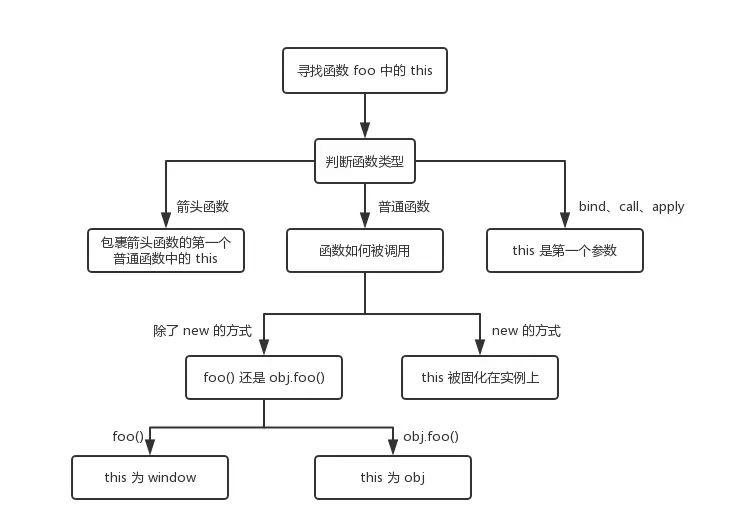<dfn id="sm46c"></dfn>
2021-4-13 前端達人
本章將專門介紹與執行上下文創建階段直接相關的最后一個細節——this是什么?以及它的指向到底是什么。
也許你在其他面向對象的編程語言曾經看過this,也知道它會指向某個構造器(constructor)所建立的對象。但事實上在JavaScript里面,this所代表的不僅僅是那個被建立的對象。
先來看看ECMAScript 標準規范對this 的定義:
「The this keyword evaluates to the value of the ThisBinding of the current execution context.」
「this 這個關鍵字代表的值為當前執行上下文的ThisBinding。」
然后再來看看MDN 對this 的定義:
「In most cases, the value of this is determined by how a function is called.」
「在大多數的情況下,this 其值取決于函數的調用方式。」
好,如果上面兩行就看得懂的話那么就不用再往下看了,Congratulations!
… 我想應該不會,至少我光看這兩行還是不懂。
先來看個例子吧:
var getGender = function() {
return people1.gender;
};
var people1 = {
gender: 'female',
getGender: getGender
};
var people2 = {
gender: 'male',
getGender: getGender
};
console.log(people1.getGender()); // female
console.log(people2.getGender()); // female
what?怎么people2變性了呢,這不是我想要的結果啊,為什么呢?
因為getGender()返回(return)寫死了people1.gender的關系,結果自然是’female’。
那么,如果我們把getGender稍改一下:
var getGender = function() {
return this.gender;
};
這個時候,你應該會分別得到female與male兩種結果。
所以回到前面講的重點,從這個例子可以看出,即便people1與people2的getGender方法參照的都是同一個getGender function,但由于調用的對象不同,所以執行的結果也會不同。
現在我們知道了第一個重點,**this實際上是在函數被調用時發生的綁定,它指向什么完全取決于函數的調用方式。**如何的區分this呢?
看完上面的例子,還是有點似懂非懂吧?那接下來我們來看看不同的調用方式對 this 值的影響。
情況一:全局對象&調用普通函數
在全局環境中,this 指向全局對象,在瀏覽器中,它就是 window 對象。下面的示例中,無論是否是在嚴格模式下,this 都是指向全局對象。
var x = 1
console.log(this.x) // 1
console.log(this.x === x) // true
console.log(this === window) // true
如果普通函數是在全局環境中被調用,在非嚴格模式下,普通函數中 this 也指向全局對象;如果是在嚴格模式下,this 將會是 undefined。ES5 為了使 JavaScript 運行在更有限制性的環境而添加了嚴格模式,嚴格模式為了消除安全隱患,禁止了 this 關鍵字指向全局對象。
var x = 1
function fn() {
console.log(this); // Window 全局對象
console.log(this.x); // 1
}
fn();
使用嚴格模式后:
"use strict" // 使用嚴格模式
var x = 1
function fn() {
console.log(this); // undefined
console.log(this.x); // 報錯 "Cannot read property 'x' of undefined",因為此時 this 是 undefined
}
fn();
情況二:作為對象方法的調用
我們知道,在對象里的值如果是原生值(primitive type;例如,字符串、數值、布爾值),我們會把這個新建立的東西稱為「屬性(property)」;如果對象里面的值是函數(function)的話,我們則會把這個新建立的東西稱為「方法(method)」。
如果函數作為對象的一個方法時,并且作為對象的一個方法被調用時,函數中的this指向這個上一級對象。
var x = 1
var obj = {
x: 2,
fn: function() {
console.log(this);
console.log(this.x);
}
}
obj.fn()
// obj.fn()結果打印出;
// Object {x: 2, fn: function}
// 2
var a = obj.fn
a()
// a()結果打印出:
// Window 全局對象
// 1
在上面的例子中,直接運行 obj.fn() ,調用該函數的上一級對象是 obj,所以 this 指向 obj,得到 this.x 的值是 2;之后我們將 fn 方法首先賦值給變量 a,a 運行在全局環境中,所以此時 this 指向全局對象Window,得到 this.x 為 1。
我們再來看一個例子,如果函數被多個對象嵌套調用,this 會指向什么。
var x = 1
var obj = {
x: 2,
y: {
x: 3,
fn: function() {
console.log(this); // Object {x: 3, fn: function}
console.log(this.x); // 3
}
}
}
obj.y.fn();
為什么結果不是 2 呢,因為在這種情況下記住一句話:this 始終會指向直接調用函數的上一級對象,即 y,上面例子實際執行的是下面的代碼。
var y = {
x: 3,
fn: function() {
console.log(this); // Object {x: 3, fn: function}
console.log(this.x); // 3
}
}
var x = 1
var obj = {
x: 2,
y: y
}
obj.y.fn();
對象可以嵌套,函數也可以,如果函數嵌套,this 會有變化嗎?我們通過下面代碼來探討一下。
var obj = {
y: function() {
console.log(this === obj); // true
console.log(this); // Object {y: function}
fn();
function fn() {
console.log(this === obj); // false
console.log(this); // Window 全局對象
}
}
}
obj.y();
在函數 y 中,this 指向了調用它的上一級對象 obj,這是沒有問題的。但是在嵌套函數 fn 中,this 并不指向 obj。嵌套的函數不會從調用它的函數中繼承 this,當嵌套函數作為函數調用時,其 this 值在非嚴格模式下指向全局對象,在嚴格模式是 undefined,所以上面例子實際執行的是下面的代碼。
function fn() {
console.log(this === obj); // false
console.log(this); // Window 全局對象
}
var obj = {
y: function() {
console.log(this === obj); // true
console.log(this); // Object {y: function}
fn();
}
}
obj.y();
情況三:作為構造函數調用
我們可以使用 new 關鍵字,通過構造函數生成一個實例對象。此時,this 便指向這個新對象。
var x = 1;
function Fn() {
this.x = 2;
console.log(this); // Fn {x: 2}
}
var obj = new Fn(); // obj和Fn(..)調用中的this進行綁定
console.log(obj.x) // 2
使用new來調用Fn(..)時,會構造一個新對象并把它(obj)綁定到Fn(..)調用中的this。還有值得一提的是,如果構造函數返回了非引用類型(string,number,boolean,null,undefined),this 仍然指向實例化的新對象。
var x = 1
function Fn() {
this.x = 2
return {
x: 3
}
}
var a = new Fn()
console.log(a.x) // 3
因為Fn()返回(return)的是一個對象(引用類型),this 會指向這個return的對象。如果return的是一個非引用類型的值呢?
var x = 1
function Fn() {
this.x = 2
return 3
}
var a = new Fn()
console.log(a.x) // 2
情況四:call 和 apply 方法調用
如果你想改變 this 的指向,可以使用 call 或 apply 方法。它們的第一個參數都是指定函數運行時其中的this指向。如果第一個參數不傳(參數為空)或者傳 null 、undefined,默認 this 指向全局對象(非嚴格模式)或 undefined(嚴格模式)。
var x = 1;
var obj = {
x: 2
}
function fn() {
console.log(this);
console.log(this.x);
}
fn.call(obj)
// Object {x: 2}
// 2
fn.apply(obj)
// Object {x: 2}
// 2
fn.call()
// Window 全局對象
// 1
fn.apply(null)
// Window 全局對象
// 1
fn.call(undefined)
// Window 全局對象
// 1
使用 call 和 apply 時,如果給 this 傳的不是對象,JavaScript 會使用相關構造函數將其轉化為對象,比如傳 number 類型,會進行new Number()操作,如傳 string 類型,會進行new String()操作,如傳 boolean 類型,會進行new Boolean()操作。
function fn() {
console.log(Object.prototype.toString.call(this))
}
fn.call('love') // [object String]
fn.apply(1) // [object Number]
fn.call(true) // [object Boolean]
call 和 apply 的區別在于,call 的第二個及后續參數是一個參數列表,apply 的第二個參數是數組。參數列表和參數數組都將作為函數的參數進行執行。
var x = 1
var obj = {
x: 2
}
function Sum(y, z) {
console.log(this.x + y + z)
}
Sum.call(obj, 3, 4) // 9
Sum.apply(obj, [3, 4]) // 9
情況五:bind 方法調用
調用 f.bind(someObject) 會創建一個與 f 具有相同函數體和作用域的函數,但是在這個新函數中,新函數的 this 會永久的指向 bind 傳入的第一個參數,無論這個函數是如何被調用的。
var x = 1
var obj1 = {
x: 2
};
var obj2 = {
x: 3
};
function fn() {
console.log(this);
console.log(this.x);
};
var a = fn.bind(obj1);
var b = a.bind(obj2);
fn();
// Window 全局對象
// 1
a();
// Object {x: 2}
// 2
b();
// Object {x: 2}
// 2
a.call(obj2);
// Object {x: 2}
// 2
在上面的例子中,雖然我們嘗試給函數 a 重新指定 this 的指向,但是它依舊指向第一次 bind 傳入的對象,即使是使用 call 或 apply 方法也不能改變這一事實,即永久的指向 bind 傳入的第一次參數。
情況六:箭頭函數中this指向
值得一提的是,從ES6 開始新增了箭頭函數,先來看看MDN 上對箭頭函數的說明
An arrow function expression has a shorter syntax than a function expression and does notbind its own
this,arguments,super, ornew.target. Arrow functions are always anonymous. These function expressions are best suited for non-method functions, and they cannot be used as constructors.
這里已經清楚了說明了,箭頭函數沒有自己的this綁定。箭頭函數中使用的this,其實是直接包含它的那個函數或函數表達式中的this。在前面情況二中函數嵌套函數的例子中,被嵌套的函數不會繼承上層函數的 this,如果使用箭頭函數,會發生什么變化呢?
var obj = {
y: function() {
console.log(this === obj); // true
console.log(this); // Object {y: function}
var fn = () => {
console.log(this === obj); // true
console.log(this); // Object {y: function}
}
fn();
}
}
obj.y()
和普通函數不一樣,箭頭函數中的 this 指向了 obj,這是因為它從上一層的函數中繼承了 this,你可以理解為箭頭函數修正了 this 的指向。所以箭頭函數的this不是調用的時候決定的,而是在定義的時候處在的對象就是它的this。
換句話說,箭頭函數的this看外層的是否有函數,如果有,外層函數的this就是內部箭頭函數的this,如果沒有,則this是window。
var obj = {
y: () => {
console.log(this === obj); // false
console.log(this); // Window 全局對象
var fn = () => {
console.log(this === obj); // false
console.log(this); // Window 全局對象
}
fn();
}
}
obj.y()
上例中,雖然存在兩個箭頭函數,其實this取決于最外層的箭頭函數,由于obj是個對象而非函數,所以this指向為Window全局對象。
同 bind 一樣,箭頭函數也很“頑固”,我們無法通過 call 和 apply 來改變 this 的指向,即傳入的第一個參數被忽略。
var x = 1
var obj = {
x: 2
}
var a = () => {
console.log(this.x)
console.log(this)
}
a.call(obj)
// 1
// Window 全局對象
a.apply(obj)
// 1
// Window 全局對象
上面的文字描述過多可能有點干澀,那么就看以下的這張流程圖吧,我覺得這個圖總結的很好,圖中的流程只針對于單個規則。

本篇文章介紹了 this 指向的幾種情況,不同的運行環境和調用方式都會對 this 產生影響。總的來說,函數 this 的指向取決于當前調用該函數的對象,也就是執行時的對象。在這一節中,你需要掌握:
藍藍設計( www.li-bodun.cn )是一家專注而深入的界面設計公司,為期望卓越的國內外企業提供卓越的UI界面設計、BS界面設計 、 cs界面設計 、 ipad界面設計 、 包裝設計 、 圖標定制 、 用戶體驗 、交互設計、 網站建設 、平面設計服務
藍藍設計的小編 http://www.li-bodun.cn